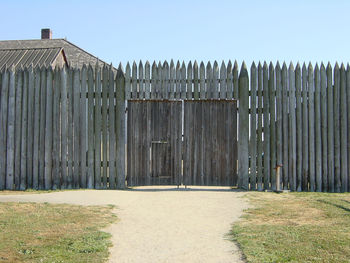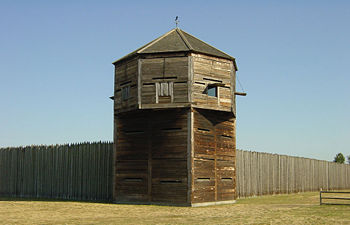Fort Vancouver (1)
| More information at Warlike, Wikidata, Wikipedia
Fort Vancouver (1825-1860) - Named after Captain George Vancouver, Fort Vancouver was a British fort established in 1825 by the Hudson's Bay Company (HBC) to support the company's fur trading operations. It officially opened for business on 19 Mar 1825 during a period of time when Great Britain and the United States were still vying for control over the areas west of the Rocky Mountains. The company was first located at Fort George on the south bank of the Columbia River which was seen as American territory. Dr. John McLoughlin had arrived in 1824 as the new Chief Factor of the Hudson's Bay Company, charged with selecting a new location that would put the headquarters in British claimed territory. The site he chose was on the north bank of the Columbia River, slightly upstream from the junction of the Willamette and Columbia Rivers. Abandoned by the HBC in 1860. See also Vancouver Barracks.
HistoryAt the end of the War of 1812 the United States and Great Britain agreed, in the Treaty of 1818, to joint occupancy of the Oregon Country for ten years. The border issues were not resolved until the 1846 treaty between Great Britain and the United States established the present-day Canadian border. Fort Vancouver was established in the middle of this period and operated under the dual jurisdictions until 1846 when the issue was resolved by the treaty. The fort was first built on a bluff overlooking the river but after four difficult years was moved down to a plain with easy access to the water. It was surrounded by broad areas of prairie and trees that sloped upward to dense forests; it became known as Jolie Prairie or Belle Vue Point because of its natural beauty. The Fort itself was the center of the largest Euro-American community on the west coast at the time with about 600 souls, and about 350 employees of the Hudson's Bay Company and their families. It was much more a community than a Fort and supported settlers, trappers, explorers, and Indians while still achieving the Hudson Bay Company's mission of a viable commercial enterprise. The populace of the fort and the surrounding area, known as Kanaka Village, were mostly Canadians; there were also English, Irish, French, Hawaiians, and a large variety of Indians. The common language spoken at the fort was Canadian French; however, trading was done in Chinook Jargon, a hodge-podge of Chinook, English, French, and Hawaiian. The stockade that protected the fort was 750 feet long, 450 feet wide, and about 20 feet high. Inside there were some 40 buildings, used for housing, warehouses, a school, a library, a pharmacy, a chapel, a blacksmith, and a large manufacturing facility. Outside the stockade, there was more housing, fields, gardens, fruit orchards, a shipyard, a distillery, a tannery, a sawmill, and a dairy. In 1845 a bastion housing three cannons were added at the northwest corner of the fort in response to a perceived threat from the Americans. The first American wagon train arrived at the fort in 1841. Initially, Fort Vancouver was the end of the Oregon Trail and provided significant support for those first settlers in defiance of the official Hudson's Bay Company Policy. The Chief Factor, Dr. John McLoughlin, became known as the "Father of Oregon" for the support he rendered to those first settlers. As the Hudson's Bay Company phased out its operation in Fort Vancouver Dr. John McLoughlin retired to Oregon City, which he founded, and became an American citizen in 1849. Oregon City then became the end of the Oregon Trail. The American YearsIn 1849 the United States Army arrived and built what would become Vancouver Barracks on the bluff above Fort Vancouver. In 1860 the Hudson's Bay Company, which had transferred its headquarters to Fort Adelaide now Fort Victoria (1), Canada in 1849, decided to abandon Fort Vancouver completely and the Hudson's Bay Company presence moved north. Fort Vancouver became a part of the Vancouver Barracks installation. By 1866 fires and decay had destroyed all the Fort Vancouver structures. Current StatusIn 1948 Congress designated Fort Vancouver as a National Monument. In 1961 the Fort became a National Historic Site and in 1996 Congress designated 366 acres that included Fort Vancouver, Vancouver Barracks and other surrounding sites as the Vancouver National Historic Reserve. Over the years the Fort has been restored and now provides a great insight into the early years of the settlement of the Northwest.
Sources:
Links: Fortification ID:
Visited: 26 Jul 2008, Aug 2005 Picture Gallery
| |||||||





